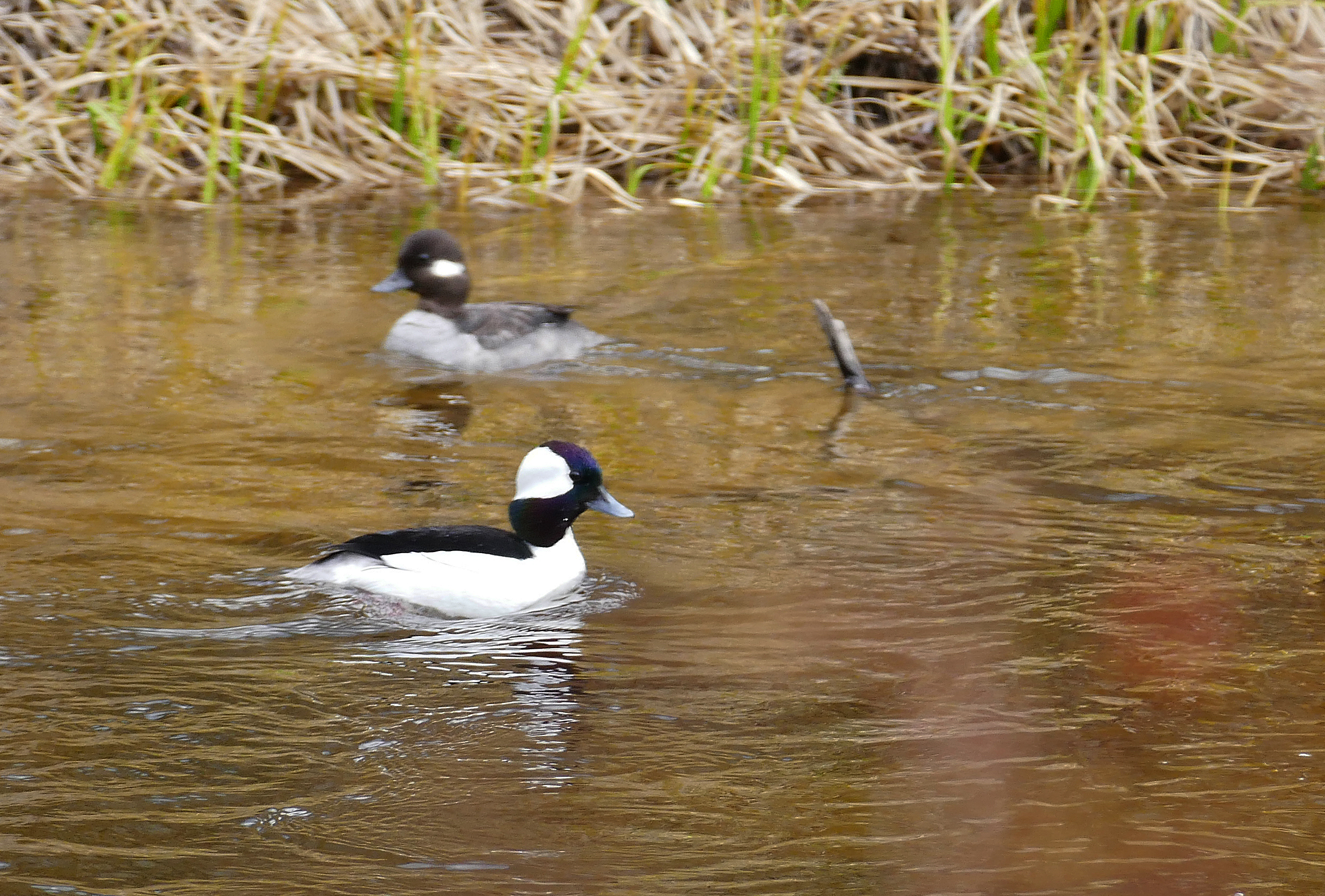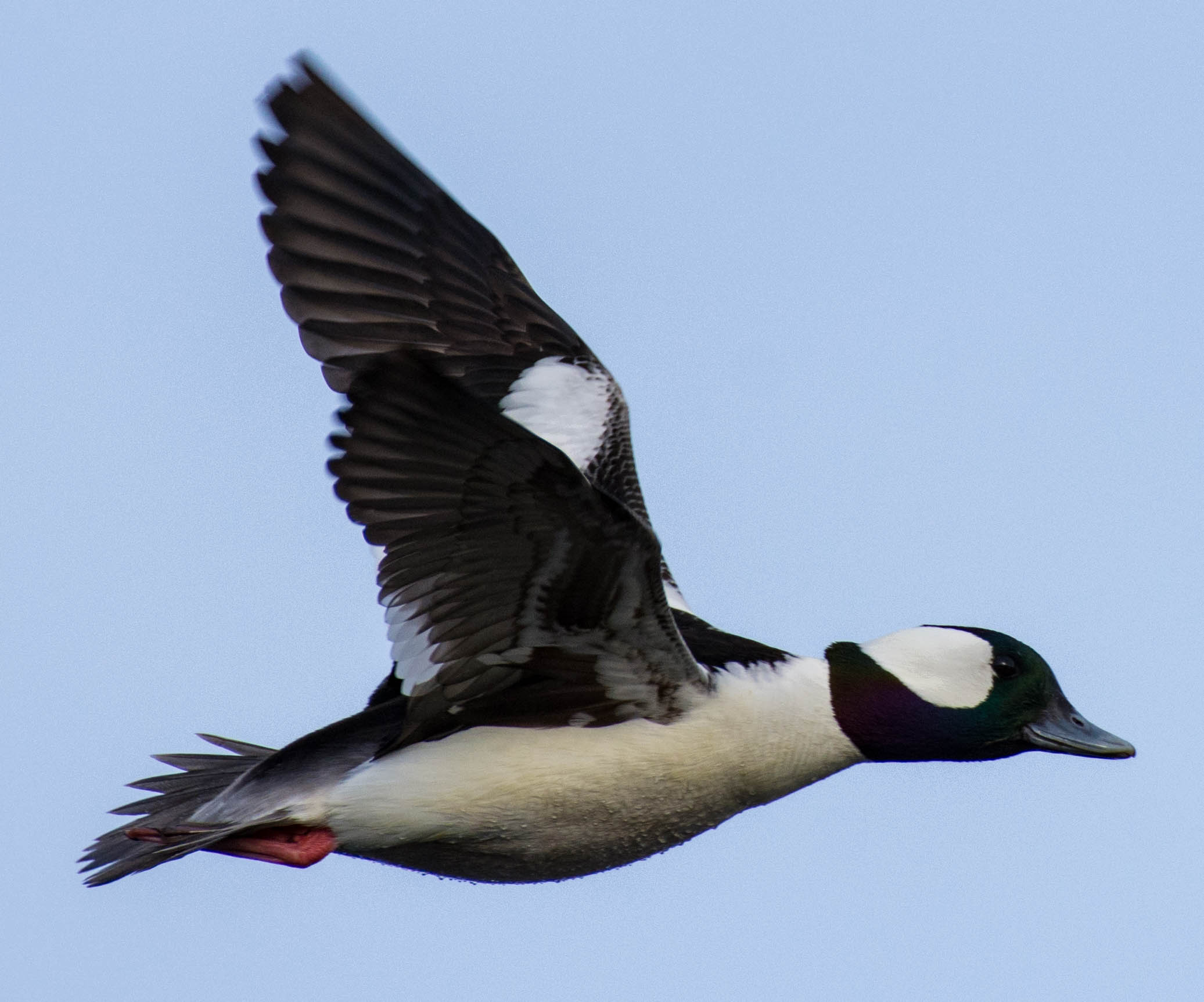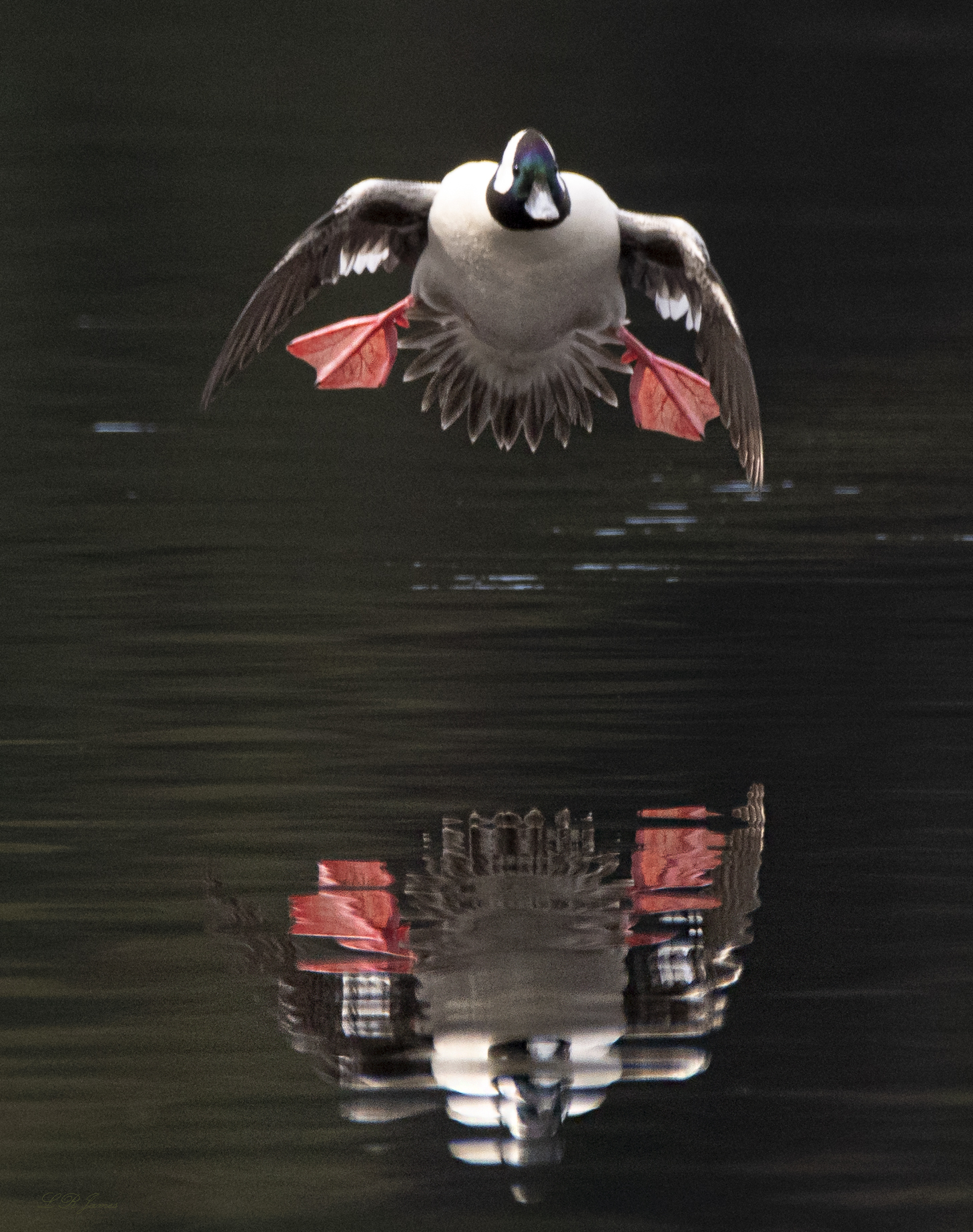
Overlooked waterfowl species:
Putting a focus on bufflehead ducks with a first-hunt story
By Kelly Riordan, WDFW R3 Hunting Coordinator
Waterfowl season is on like Donkey Kong right now in Washington. The Pacific flyway has a plethora of species. From the speedy green-winged teal to the majestic drake pintail, hunters can see many kinds of quackers, squeakers, or whistlers.
Just as there are many varieties of waterfowl, there are also many places and tactics to hunt them. For more advanced waterfowlers, that’s great! How about for the new hunter who just wants to go out to a waterway and give duck hunting a try? In the passages below, there are many tips to help new waterfowlers. We hope that this story will become a similar one to your own in the future.

A drake and hen bufflehead are seen in the upper Chewuch River in Okanogan County. (Scott Fitkin/WDFW)

A male bufflehead in flight. (Dennis Werlau/WDFW)
As a lifelong waterfowl hunter, I remember my father taking me out duck hunting for the first time after completing hunter education. My dad had purchased this plain-looking, break-barrel, single-shot 20-gauge shotgun. I had gone out with him several times practicing safety and shooting with sitting targets, then with clay pigeons thrown from one of those hand-held clay-pigeon flingers. At the time, I was proud of my 60 percent hit rate, but I attribute that rate to only having one or maybe two shots per clay pigeon. It was decided that I was ready to give duck hunting a try.
The morning of the hunt arrived, and that chilly October morning provided us with just-above-freezing temperatures accompanied by a sticky fog. The attire for the day was not merino base layers and cool digital camo, no! I was in some hand-me-down long johns from my older brother, three pairs of cotton socks, a pair of blue jeans, and I believe every long-sleeve shirt I owned. Oh yeah, and my black school coat (never told my mother about that). The only “specialized” equipment that I had was a pair of rubber thigh-high waders that my dad had purchased from the local sporting goods store.
Our venue was a saltwater slough deep in the tidal confines of Puget Sound. This piece of land was owned by a local shellfish company. We had swung by their headquarters a few weeks prior and asked for permission to duck hunt. After one of the owners talked to us about their land use rules and shooting safety, we were given the green light.
On the big day, I purchased my first state small game license and federal duck stamp. Since identification is important to me, I had also procured the Audubon western bird identification book. I studied it while at home and on several trips to Hood Canal while fall salmon fishing. At the time, I was a professional at spotting flying and on-the-water buffleheads, goldeneye, and scoter. Yes, I knew what a mallard looked like, but fishing for chum at the Hoodsport Hatchery, I mostly saw species commonly known as divers and sea ducks.
“Time slowed, but events happened quite quickly. The hammer back, I dropped the bead of the barrel right down on the drake bufflehead. He couldn’t have been an inch longer than 20-yards out when I saw his feet drop down in preparation for landing. I don’t even remember the shotgun going off.”

A drake bufflehead comes in for a landing at Hicks Lake in Lacey. (Larry James)
On hunt day and arriving at the gate, I was expecting to unload a literal ton of gear. After all, that’s what the magazine said I needed. Instead, dad dropped down the tailgate of our old pickup and handed me two mallard decoys and one piece of folded up (and quite stinky) brown burlap. Confused, but trusting the seasoned hunter, I started my penguin-like walk toward the water. Luckily, dad carried my shotgun as I fumbled with the little bit of gear I had.
Walking over 100 miles, or what seemed like it with my clothing selection weighing me down, we made the quarter-mile hike to the water’s edge. We, or should I say dad, had read the local tide guide and timed our hunt with an incoming tide. One funny thing I remembered is that my dad had brought a fishing rod. At the time I just thought he might throw out a lure if the hunting was slow.
Surveying the shoreline, we selected a small spit of land that had an old log laying parallel to the beach. The way the tide was coming in, it created a nice little eddy that I’m sure a few sea-run cutthroat were hanging out below. It was explained that we would set the two decoys in the soft water behind the point and the ducks would fly right into this calm, protected water once they saw the decoys.
Unwrapping the 10-foot decoy line and decoy weights, I reared back and was ready to heave the decoy halfway to Canada when I heard a barking behind me. Not a dog, nope. It was my dad heightening his voice to inform me that we would be simply setting the decoys down at the water’s edge. Poking a little fun at him, I stated something to the effect of “yeah, like that’ll bring ’em in.” I’m lucky because my hunt mentor of a father had more patience than a tree. He explained the tide was on its way in (higher up the beach) and that within the hour, the decoys would be in perfect position.
Still, I quietly questioned his motives, but we moved on. The next to-do was the duck blind. Aw, I was ready to go gather tree limbs, pull up every piece of seaweed, and cover us up like professionals. Nope, wrong again. At the base of that slimy old tree that had been peacefully left by a high tide, he simply sat down behind the main part of the tree and the root wad. I went and sat down next to him on the open water side, and he laid the (still stinky) burlap across us like a throw blanket. This wasn’t what I had imagined at all! In my mind, there was NO WAY a smart ol’ duck would commit to our decoys with us just sitting there.
Finger to lips and a “shhhh” that followed, it was time to hunt. The shotgun was handed over. I cracked the barrel open, checked it for a shell, and held tight onto a yellow shotshell that was handed to me. Dad had purchased one box of shells. They were 2 ¾ inch, steel 2-shot for 20-gauge shotguns. We didn’t have to wait long. In my disbelief, two birds came screaming in like little fighter jets toward the point not 15 minutes later. Before my dad could ask, I barked out “BUFFLEHEADS” and the birds flared and sped off. Lesson quickly learned.
The fly-overview
Bufflehead ducks are a good starter species for hunting. Some advantages include that they:
- are easy to target in your hunt.
- can be drawn in with only one or two decoys.
- can be hunted with just a small game license, migratory bird permit, and federal duck stamp. There are no special permits, tags, or harvest record cards needed.
- are easy to identify.
- make good table fare.
Another 20 minutes or so later and after a few high-flying ducks came by, here came two more (or the same two) buffleheads, a beautiful white-and-black-headed drake and his hen. I whispered, “buffleheads dad.” The tide had come up and the decoys had floated up too, just like I was told they would. I carefully loaded the shotshell. I had been instructed to wait until I saw their feet flop down like landing gear. Pulling the hammer back was much easier this time for some reason. In practice, I would often struggle with it, but not that pull-back.
Time slowed, but events happened quite quickly. The hammer back, I dropped the bead of the barrel right down on the drake bufflehead. He couldn’t have been an inch longer than 20-yards out when I saw his feet drop down in preparation for landing. I don’t even remember the shotgun going off. Just the smell of spent powder and the view of the drake splashing into the water.
Ears ringing (I know, I should have had some hearing protection), I jumped up and yelled out something, but I don’t remember what. I did remember my muzzle control and ejected my spent shotshell. Then a question dawned on me: How the heck am I gonna get this duck?! My first duck! My mind spiraled out of control in panic. With a smirk, my father reached behind the log and pulled out the fishing rod. I had failed to notice that there was no lure, just a piece of weight and a treble hook. He had obviously done this before. Just two casts and in came the duck! Still pacing on the shoreline, I walked out as far as my waders would allow, reached with the arms of a crane and grabbed up my bufflehead.
There were high-fives and even a hug. I told dad the story like he hadn’t even been there. We ended the hunt shortly after the celebration. It was agreed prior to the hunt that we would stop after one or two birds, and I would learn field care. The fishing rod was used to retrieve the decoys and we headed toward home.
Having a dad teach me cleaning, plucking, and later cooking ducks really carved out a path for my hunting future. It wasn’t just that one hunt either. We went several more times, well, every time until I was old enough to go solo or with other hunters.
Now I look at the resources available to new hunters and smile a bit. Organizations like First Hunt Foundation and the Washington Department of Fish and Wildlife can really assist new hunters. Notice I didn’t just say young hunters. All hunters. Any new hunter can use the support, and we hear you. Try out a few of the links below and heck, write me an email, and I’ll point you in the right direction.
Shoot straight,
Kelly Riordan, WDFW R3 Hunting Coordinator
Helpful links
To learn more about duck hunting and take advantage of helpful resources, you can visit these websites:
- WDFW: For more information on the Washington Department of Fish and Wildlife
- Washington’s world of waterfowl: A primer on duck hunting prep, gear, tactics, and resources
- The minimalist waterfowler: How-to guide
- Let’s go waterfowling: WDFW information on where and how to hunt waterfowl
- WDFW recruitment, retention, and reactivation (R3): The agency’s hunting and angling R3 plan
- First Hunt Foundation: A national organization dedicated to keeping the hunting heritage alive through mentoring new hunters
- Buffleheads: Species identification and behavior information from the Cornell Lab
- Licenses: You can buy your hunting licenses by calling 360-902-2464, visiting https://fishhunt.dfw.wa.gov/login, or going to a license dealer near you. Go to https://wdfw.wa.gov/licenses/dealersto find your nearest license dealer.
- Places to Go: WDFW information on finding places to go hunting
- Hunter education: WDFW resources for hunter education



